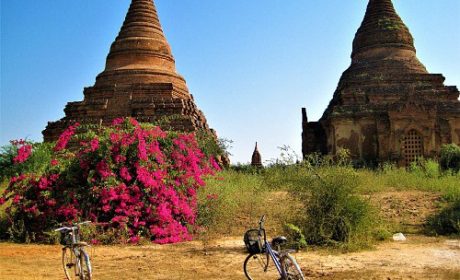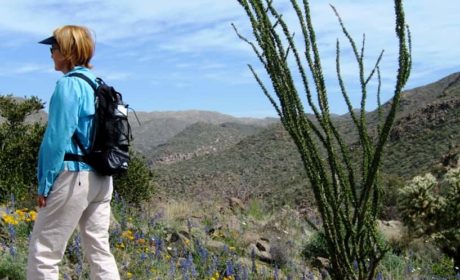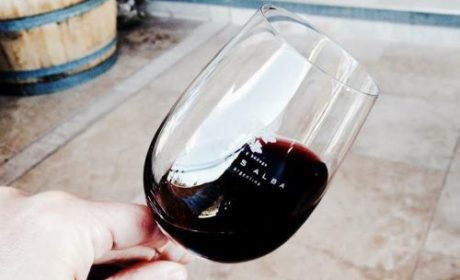While we enjoy active travel of any sorts, we absolutely adore off-the-beaten path adventures in faraway lands. Guest writers, Sarah and Laura from Wandercooks, are here to tell us all about their Japanese adventures biking the beautiful Kibiji bike trail.
Japan is a complex and beautiful country that brings to mind both ancient temples and incredible modern technology. It’s one of our favorite countries to explore as self-guided travelers for its stunning views, incredible street food, and warm, welcoming people.
It’s easy to get lost in the glamour of the big cities like Osaka and Tokyo, but to really gain insight into everyday life in Japan, you need take the time to venture out into the Japanese countryside.
One of the best ways to do this is by bicycle. Not only is it great exercise and lots of fun, but biking through Japan is a great way to explore more freely and take things in at your own pace.
Table of Contents
Kibiji Bike Trail

Biking through Japan on the Kibiji Bike Trail is a cyclist’s dream. Beginning at Bizen-Ichinomiya Station just west of Okayama and ending at Soja Station around 10.5 miles away, the trail is steeped in history and folklore.
Exhilarating and peaceful, the trail weaves its way through tiny rural villages and across flat, tranquil farmlands. You’ll find plenty of stops along the way.
Visit Buddhist temples, shrines, and ancient burial mounds that rise up from the surrounding plain. Even better, it’s mostly flat the entire way, leaving you free to gaze out across the landscape towards the mountains in the distance.
Begin your Japan biking adventure in Okayama

We started the Kibiji Trail in Okayama, which added a few extra kilometers to our trip, but meant we didn’t have to catch a train to the main starting point at Bizen-Ichinomiya station. You can hire bikes from either the official starting point or at Okayama Station (for a fraction of the price) and ride the few extra kilometers to the starting point if you’d like.

Jumping on our bikes, it wasn’t long before we left the busy city streets of Okayama behind and found ourselves out in the open countryside; the wind in our hair and the bitumen trail beneath our wheels.
Boomer Travel Tip
MedjetAssist Members who are hospitalized 150 miles from home receive medical transport to a home-country hospital of choice. Memberships from $99.
Stop at the Kibitsuhiko Shrine
Following the white and blue Kibiji Trail signs led us to our first stop for the day at Kibitsuhiko Shrine, where we parked the bikes and took in the views of its gorgeous pond and large red lanterns.
See Japan’s oldest Shinto shrine at Kibitsu Jinja
Next stop was Kibitsu Jinja, one of the biggest and oldest Shinto shrines in Japan. According to the famous folklore ‘Momotaro’, this is where Prince Kibitsuhiko battled an ogre that was threatening the Kibi Kingdom.
Following the trail through fascinating rural villages, we soon found ourselves riding beside the enormous Tsukuriyama-kofun Burial Mound. While we didn’t stop here, we found out later that it’s possible to venture up to a shrine at the top of the burial mound if you have the time.
Visit Bitchu-Kokubunji, an 8th century Buddhist temple

By far the most beautiful stop on our journey was at Bitchu-Kokubunji, an 8th century Buddhist temple. The impressive five-story pagoda draws your eye for miles before you reach the temple grounds.

On the day we arrived the pagoda was surrounded by blooming cherry blossoms. After exploring the temple grounds we spent some time people watching, and saw groups of people sharing ‘hanami’ picnics under the blossoms.
Soja is the end of the Kibiji trail for most cyclists
It wasn’t long before we reached the town of Soja, effectively the end of the Kibiji trail for most cyclists. However we were keen to make the return trip after a quick stop for lunch.
By the time we eventually found an udon restaurant, we were famished. Those udon noodles didn’t stay in their bowls for long!
Returning to Okayama
Back on the trail for the return trip to Okayama we lost ourselves in conversation and realized we were no longer on the Kibiji trail. We weren’t too fussed about being lost, since we had our maps app and knew where we were.
It was a little disappointing to miss out on the final stretch of peace and quiet on the trail. Instead we found ourselves battling traffic, crossing bridges and weaving our way through city streets and back to our accommodation in Okayama.
Still, the coffee and matcha parfait from a little cafe that we found made it all worthwhile.
Kijibi Trail travel tips
- Grab the free English version of the Kibiji Trail Guide – this proved to be very handy, especially since we were traveling without mobile data. It highlights the route you should take and all the interesting things to see along the way. The guide is available at the Tourism Office at Okayama Station or from the official start of the trail at Bizen-Ichinomiya Station.
- Hire a bike – Bike hire costs around 1000¥ (around $6.77) for the day from Uedo Rent-a-cycle at Bizen-Ichinomiya, and you can opt to leave your bike at the end point in Soja. Alternatively you can hire a bike from JR Eki Rinkun Rent-a-cycle at Okayama Station for 350¥ (around $2.37) per day.
- Keep a lookout for the white and blue trail signs – Spaced out at intervals along the trail, the signs are written in English and Japanese and give you handy distances to the start and end points and upcoming destinations along the trail.
- Watch out for traffic – You’ll navigate a few city streets before you reach the Kibiji Trail proper. In Japan, cars drive on the left but you’ll find that most cyclists ride on the footpath, so feel free to do the same.
- Pack some snacks – Fuel up at one of the ubiquitous 7-Eleven or Lawson convenience stores. Most Lawson stores feature blue signage, but if you find one with green signage you can choose from a huge range of freshly prepared food starting from just 100¥ each (around $0.67), from onigiri rice ball snacks to full bento boxes. Grab some supplies, some water and/or energy drinks to keep you going throughout the day.
- Check the weather – If it’s sunny, wear sunscreen and a shady hat. If you’ve got flowy long sleeves that will protect you from the sun but keep you cool, even better. If it’s looking rainy, like it was the day we cycled the Kibiji Trail, you might want to bring an umbrella, poncho or waterproof covering for your backpack. You can find all of these from a Japanese ‘Hyakuen’ or 100¥ (+ tax) shop [around $0.67 depending on the exchange rate]. The most popular hyakuen is known as Daiso – look for the bright pink signage.
More boomer travel fun in Japan
Japan is filled with experiences that will seem exotic to most Americans. We have tips for planning your own Japanese adventure as well as a first-timers thoughts on Japan. Check more of the things we think you should do.
- Spend a day in Nagasaki to experience WWII history
- Visit Jigokudani Monkey Park in Yudanaka
- Explore Nara for the giant Buddha and roaming deer



